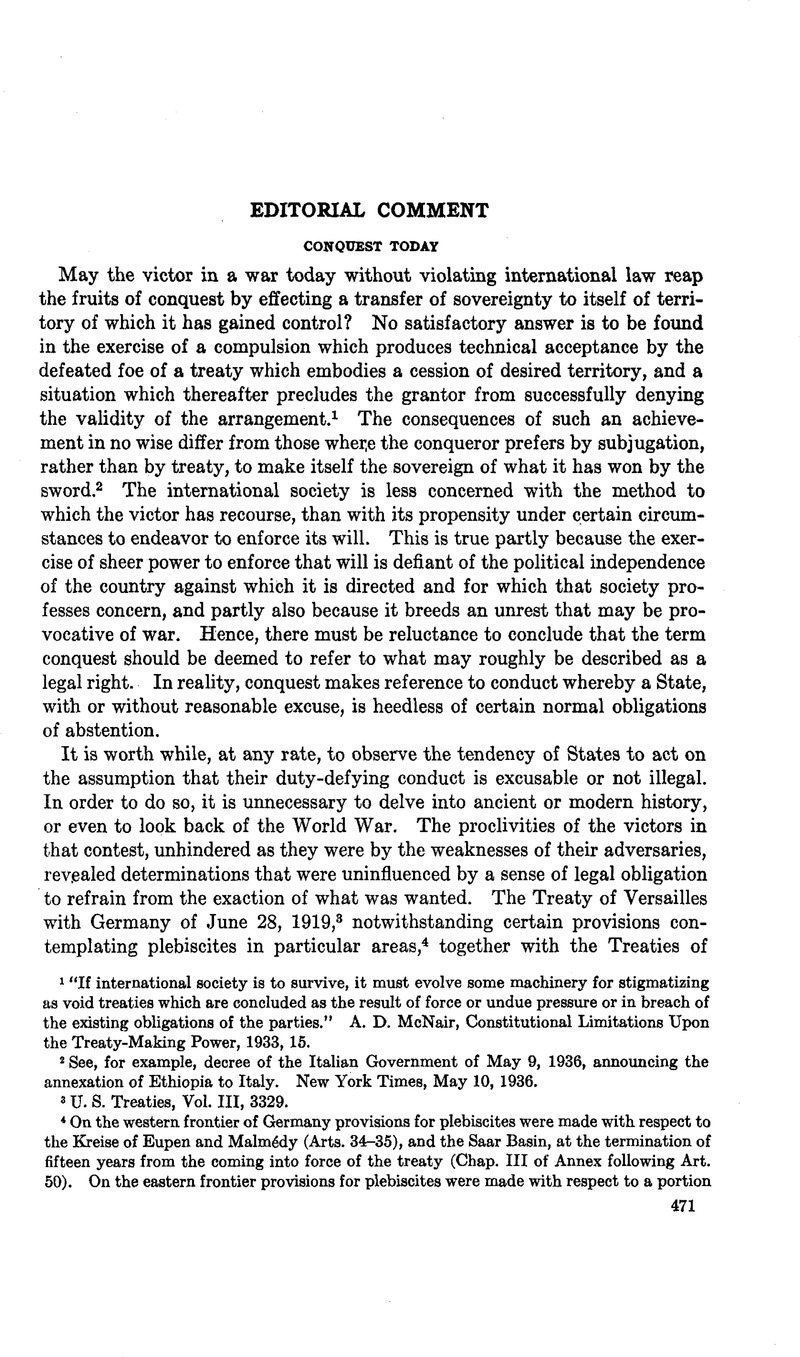
1 “If international society is to survive, it must evolve some machinery for stigmatizing as void treaties which are concluded as the result of force or undue pressure or in breach of the existing obligations of the parties.” McNair, A. D., Constitutional Limitations Upon the Treaty-Making Power, 1933, 15 Google Scholar.
2 See, for example, decree of the Italian Government of May 9, 1936, announcing the annexation of Ethiopia to Italy. New York Times, May 10, 1936.
3 U. S. Treaties, Vol. Ill, 3329.
4 On the western frontier of Germany provisions for plebiscites were made with respect to the Kreise of Eupen and Malmédy (Arts. 34–35), and the Saar Basin, at the termination of fifteen years from the coming into force of the treaty (Chap. III of Annex following Art. 50). On the eastern frontier provisions for plebiscites were made with respect to a portion of Upper Silesia (Art. 88, and Annex), and two specified areas of East Prussia (Arts. 94–97). According to Art. 109, the frontier between Germany and Denmark was to be fixed “in conformity with the wishes of the population,” and to that end provision was made for a plebiscite in a definite area of Schleswig. See, in this connection, letter of M. Clemenceau in behalf of the Allied and Associated Powers, to Count von Brockdorff-Rantzau, President of the German Peace Commission at Paris, June 16, 1919, in reply to German counterproposals, Conditions of Peace with Germany, Senate Doc. No. 149, 66 Cong., 1 Sess., 97. See also, Wambaugh, Sarah, Plebiscites Since the World War, Washington, 1933 Google Scholar.
5 U. S. Treaties, Vol. III, 3149.
6 British Treaty Series (1920), No. 5, Cmd. 522.
7 U. S. Treaties, Vol. III, 3539.
8 British Treaty Series (1920), No. 11, Cmd. 964.
9 League of Nations Treaty Series, XXVIII, 11.
10 See Quincy Wright, “Article 19 of the League Covenant and the Doctrine Rebus Sic Stantibus,” Proceedings, Annual Meeting, American Society of International Law, 1936, p. 55, in which that writer adverts to the contrasting provisions of Art. III of President Wilson’s first draft of the Covenant (Miller’s Drafting of the Covenant, II, 12) and to Lord Robert Cecil’s draft of Jan. 20, 1919 (Id., II, 106 and 107).
See, also, Williams, John Fischer Sir, Some Aspects of the Covenant of the League of Nations, London, 1934, 177 Google Scholar.
11 The purpose of marshaling the facts set forth hereinabove is to accentuate what the Allied and Associated Powers appeared to believe that they might not unlawfully achieve rather than to suggest the unwisdom of the policy to which they had recourse; for it is here sought primarily to take cognizance of what the law of nations is deemed generally to permit or proscribe.
12 See address of Jan. 8, 1918, announcing fourteen points as a proposed basis for peace, For. Rel. 1918, Supp. 1, Vol. I, 12; also address of Sept. 27, 1918, id., 316.
13 See statement of Feb. 10,1920, in relation to certain proposals offered to the Yugoslav Delegation by the British and French Governments, Jan. 14, 1920, pertaining to the adjustment of the dispute concerning the territorial limits of the Serb-Croat-Slovene Kingdom, as published in Congressional Record, Feb. 27, 1920, LIX, No. 66, pp. 3783–3784.
14 See statement of Jan. 7, 1932, addressed to the Chinese and Japanese Governments, Dept, of State, Press Release, Jan. 9, 1932, Publication No. 271, p. 41.
15 See Resolution adopted by the Assembly of the League of Nations, March 11, 1932, Official Journal, Special Supplement, No. 101, 1932, Vol. I, p. 87.
16 Dept, of State, Press Release, Aug. 6, 1932, Publication No. 350, p. 100. Cf. communication from the Government of the Argentine Republic to the Commission of Neutrals at Washington in relation to the declaration of the nineteen American Republics, as published in the New York Times, Nov. 19, 1932.
17 Appendix 23 to Report of the Delegates of the United States of America to the Seventh International Conference of American States, Dept, of State, Conference Series, No. 19.
18 U. S. Treaty Series, No. 881.
19 Such territory as the United States won from Spain in consequence of the war with that country in 1898 underwent a change of sovereignty that did little or no violence to the occupants of what was ceded.
If it be contended that the force exerted by the United States which was productive of the acceptance by Haiti of the treaty with that country of Sept. 16, 1915 (U. S. Treaties, Vol. Ill, 2673), marked the exercise of a compulsion which was analogous to conquest (see Inquiry into Occupation and Administration of Haiti and the Dominican Republic, Report of Senate Investigating Committee, Senate Doc. No. 794, 67 Cong., 2 Sess., 335, 355, 393–394), it should be borne in mind that the agreement with that country of Aug. 7, 1933 (U. S. Executive Agreement Series, No. 46), which served to terminate the Additional Act of March 22, 1917, through which the treaty of 1915 was extended, marked the beginning of a renunciation of a control by the United States which should ultimately be productive of the freedom of Haiti from external control. See, also, U. S. Executive Agreement Series, No. 68, of July 24, 1934.